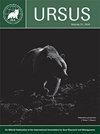美国乔治亚州美国黑熊的种群遗传学
IF 0.8
4区 生物学
Q4 ZOOLOGY
引用次数: 2
摘要
摘要:美国佐治亚州有3个美洲黑熊(Ursus americanus)种群。我们使用从这些种群中收集的熊毛和组织样本中提取的多位点微卫星基因型来评估种群内和种群间的遗传多样性水平。我们使用种群分配聚类来评估最近是否有移民进入3个种群中最小的格鲁吉亚中部熊种群。与美国其他熊种群相比,北乔治亚和南乔治亚熊种群具有较高的遗传多样性(Ho = 0.72±0.02,A = 6.68±0.32,Ho = 0.72±0.02,A = 6.82±0.35)。相比之下,格鲁吉亚中部熊种群的发病率相对较低(Ho = 0.46±0.03,A = 3.96±0.20)。格鲁吉亚熊种群之间配对的固定指数表明,北格鲁吉亚熊种群与南格鲁吉亚熊种群的相似性大于格鲁吉亚熊种群与中部格鲁吉亚熊种群的相似性。我们的研究结果表明,格鲁吉亚中部熊种群经历了长期的遗传隔离和遗传漂变。在佐治亚州中部的365只熊的样本中,我们只发现了1只移民,没有证据表明基因流入了种群。我们建议制定和实施计划,鼓励基因流向格鲁吉亚中部熊种群。本文章由计算机程序翻译,如有差异,请以英文原文为准。
Population genetics of American black bears in Georgia, USA
Abstract: There are 3 American black bear (Ursus americanus) populations in the state of Georgia, USA. We used multi-locus microsatellite genotypes derived from bear hair and tissue samples collected across these populations to assess levels of genetic diversity within and between populations. We used population assignment clustering to evaluate whether there has been recent immigration into the smallest of the 3 populations, the Central Georgia Bear Population. Compared with other bear populations in the United States, the North Georgia and South Georgia Bear Populations have relatively high rates of genetic diversity (Ho = 0.72 ± 0.02, A = 6.68 ± 0.32, and Ho = 0.72 ± 0.02, A = 6.82 ± 0.35, respectively). In contrast, the Central Georgia Bear Population has relatively low rates (Ho = 0.46 ± 0.03, and A = 3.96 ± 0.20). Fixation indices for pairings between Georgia bear populations indicated that the North Georgia Bear Population was more similar to the South Georgia Bear Population than either was to the Central Georgia Bear Population. Our findings suggest that the Central Georgia Bear population has experienced long-term genetic isolation and genetic drift. Of a sample of 365 bears from Central Georgia, we only detected 1 immigrant and no evidence of gene flow into the population. We recommend development and implementation of plans to encourage gene flow toward the Central Georgia Bear Population.
求助全文
通过发布文献求助,成功后即可免费获取论文全文。
去求助
来源期刊

Ursus
生物-动物学
CiteScore
2.00
自引率
15.40%
发文量
12
审稿时长
>12 weeks
期刊介绍:
Ursus includes a variety of articles on all aspects of bear management and research worldwide. Original manuscripts are welcome. In addition to manuscripts reporting original research, submissions may be based on thoughtful review and synthesis of previously-reported information, innovative philosophies and opinions, and public policy or legal aspects of wildlife conservation. Notes of general interest are also welcome. Invited manuscripts will be clearly identified, but will still be subject to peer review. All manuscripts must be in English. All manuscripts are peer-reviewed, and subject to rigorous editorial standards.
 求助内容:
求助内容: 应助结果提醒方式:
应助结果提醒方式:


